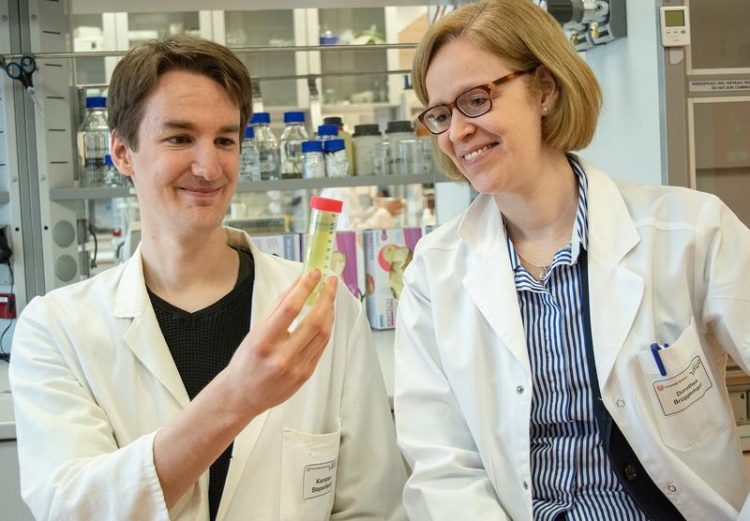“Biological Bandage” Could Help Heal Wounds

Is the "biological bandage" coming soon? A team of researchers at the University of Bremen led by Dorothea Brüggemann and Karsten Stapelfeldt has now created a fibrinogen network Kai Uwe Bohn / University of Bremen
Humans are vulnerable: one cut and they bleed. Fortunately, nature has its own solutions at the ready to treat minor injuries at the least: in order to close the wound quickly and enable the healing process, the protein fibrinogen, which is contained in blood plasma, is converted into fibrin and forms nanofibers. The scab develops.
The resulting tissue of microscopically fine fibers ensures that the wound closes and also supports healing. A team of biophysicists from the University of Bremen led by Professor Dorothea Brüggemann and doctoral student Karsten Stapelfeldt has now succeeded in creating such a biological fibrinogen network in the laboratory. The discovery promises new possibilities in wound care in the future.
Material from Our Own Blood
“Normally, when you have a wound, you can help yourself with bandages and compresses, which also represent a tissue, albeit a synthetic one,” explains Dorothea Brüggemann. “Our process enables biological wound dressings that could even be formed from a person’s own blood.”
Put simply, every human being could one day have their own “biological bandage,” which is ideally accepted by the body and has clear advantages in wound care, but also as a coating for implants.
A random discovery under the scanning electron microscope helped the Bremen research team. Doctoral student Karsten Stapelfeldt investigated the self-organization process that turns dissolved proteins into ultrafine fibers that then combine to form tissue. “Fibers appeared in places we didn’t expect them to,” he says. The research group was interested and focused their research on the formation of fibrinogen networks.
Natural Wound Dressing: Will We Soon Be Able to Get Scabs in a Tube?
“In the end, we succeeded in producing a layer several micrometers thick of the natural fibrinogen structure – something that you can actually take charge of. This can become the basis for a ‘natural’ wound dressing – in other words, scabs in a tube,” explains Karsten Stapelfeldt.
The “individual bandage,” which is made of our own organic material, was made possible by the Bremen discovery: “There’s never been anything like this before. Maybe one day people will have blood taken as infants in order to have such fibrinogen bandages ‘in stock’ for them,” wonders Dorothea Brüggemann.
“We see great potential for the future in this discovery.” This is why the team has filed a European patent application with the help of Bremen patent agency InnoWi GmbH.
The researchers in Dorothea Brüggemann’s working group still have a lot of work to do before the development comes close to being used in real life: “We will now test how cell cultures react to our fibrinogen networks, how they grow under certain conditions, and what the mechanical stability of the structures is like.”
The scientist heads the Emmy Noether research group for nanoBiomaterials, which is funded by the Deutsche Forschungsgemeinschaft (DFG – German Research Foundation), at the Institute for Biophysics at the university. The Emmy Noether Programme supports particularly qualified junior researchers.
The research results of the Bremen working group have now been published on the International Society for Biofabrication website: https://iopscience.iop.org/article/10.1088/1758-5090/ab0681.
Professor Dorothea Brüggemann
Emmy Noether research group
Institute for Biophysics
Faculty of Physics/Electrical Engineering
University of Bremen
Tel.: +49 421 218-62286
E-mail: brueggemann@uni-bremen.de
Media Contact
More Information:
http://www.uni-bremen.deAll latest news from the category: Life Sciences and Chemistry
Articles and reports from the Life Sciences and chemistry area deal with applied and basic research into modern biology, chemistry and human medicine.
Valuable information can be found on a range of life sciences fields including bacteriology, biochemistry, bionics, bioinformatics, biophysics, biotechnology, genetics, geobotany, human biology, marine biology, microbiology, molecular biology, cellular biology, zoology, bioinorganic chemistry, microchemistry and environmental chemistry.
Newest articles

Silicon Carbide Innovation Alliance to drive industrial-scale semiconductor work
Known for its ability to withstand extreme environments and high voltages, silicon carbide (SiC) is a semiconducting material made up of silicon and carbon atoms arranged into crystals that is…

New SPECT/CT technique shows impressive biomarker identification
…offers increased access for prostate cancer patients. A novel SPECT/CT acquisition method can accurately detect radiopharmaceutical biodistribution in a convenient manner for prostate cancer patients, opening the door for more…

How 3D printers can give robots a soft touch
Soft skin coverings and touch sensors have emerged as a promising feature for robots that are both safer and more intuitive for human interaction, but they are expensive and difficult…





















